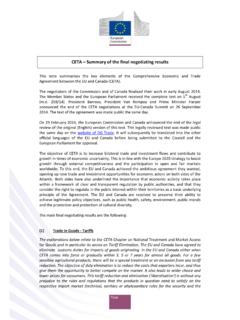Transcription of Cross-subsidy surcharge and additional surcharge for open ...
1 The Gazette of India EXTRAORDINARY PART I - Section 1 PUBLISHED BY AUTHORITY Ministry of Power New Delhi, Dated the 6th January, 2006 RESOLUTION ( ) TARIFF POLICY INTRODUCTION In compliance with section 3 of the Electricity Act 2003 the Central Government hereby notifies the Tariff policy in continuation of the National Electricity Policy (NEP) notified on 12th February 2005. The National Electricity Policy has set the goal of adding new generation capacity of more than one lakh MW during the 10th and 11th Plan periods to have per capita availability of over 1000 units of electricity per year and to not only eliminate energy and peaking shortages but to also have a spinning reserve of 5% in the system. Development of the power sector has also to meet the challenge of providing access for electricity to all households in next five years.
2 It is therefore essential to attract adequate investments in the power sector by providing appropriate return on investment as budgetary resources of the Central and State Governments are incapable of providing the requisite funds. It is equally necessary to ensure availability of electricity to different categories of consumers at reasonable rates for achieving the objectives of rapid economic development of the country and improvement in the living standards of the people. Balancing the requirement of attracting adequate investments to the sector and that of ensuring reasonability of user charges for the consumers is the critical challenge for the regulatory process. Accelerated development of the power sector and its ability to attract necessary investments calls for, inter alia, consistent regulatory approach across the country.
3 Consistency in 1approach becomes all the more necessary considering the large number of States and the diversities involved. LEGAL POSITION Section 3 (1) of the Electricity Act 2003 empowers the Central Government to formulate the tariff policy. Section 3 (3) of the Act enables the Central Government to review or revise the tariff policy from time to time. The Act also requires that the Central Electricity Regulatory Commission (CERC) and State Electricity Regulatory Commissions (SERCs) shall be guided by the tariff policy in discharging their functions including framing the regulations under section 61 of the Act. Section 61 of the Act provides that Regulatory Commissions shall be guided by the principles and methodologies specified by the Central Commission for determination of tariff applicable to generating companies and transmission licensees.
4 The Forum of Regulators has been constituted by the Central Government under the provisions of the Act which would, inter alia, facilitate consistency in approach specially in the area of distribution. EVOLUTION OF THE POLICY The tariff policy has been evolved in consultation with the State Governments and the Central Electricity Authority (CEA) and keeping in view the advice of the Central Electricity Regulatory Commission and suggestions of various stakeholders. OBJECTIVES OF THE POLICY The objectives of this tariff policy are to: (a) Ensure availability of electricity to consumers at reasonable and competitive rates; (b) Ensure financial viability of the sector and attract investments; (c) Promote transparency, consistency and predictability in regulatory approaches across jurisdictions and minimise perceptions of regulatory risks; (d) Promote competition, efficiency in operations and improvement in quality of supply.
5 GENERAL APPROACH TO TARIFF Introducing competition in different segments of the electricity industry is one of the key features of the Electricity Act, 2003. Competition will lead 2to significant benefits to consumers through reduction in capital costs and also efficiency of operations. It will also facilitate the price to be determined competitively. The Central Government has already issued detailed guidelines for tariff based bidding process for procurement of electricity by distribution licensees for medium or long-term period vide gazette notification dated 19th January, 2005. All future requirement of power should be procured competitively by distribution licensees except in cases of expansion of existing projects or where there is a State controlled/owned company as an identified developer and where regulators will need to resort to tariff determination based on norms provided that expansion of generating capacity by private developers for this purpose would be restricted to one time addition of not more than 50% of the existing capacity.
6 Even for the Public Sector projects, tariff of all new generation and transmission projects should be decided on the basis of competitive bidding after a period of five years or when the Regulatory Commission is satisfied that the situation is ripe to introduce such competition. The real benefits of competition would be available only with the emergence of appropriate market conditions. Shortages of power supply will need to be overcome. Multiple players will enhance the quality of service through competition. All efforts will need to be made to bring power industry to this situation as early as possible in the overall interests of consumers. Transmission and distribution, the wires business is internationally recognized as having the characteristics of a natural monopoly where there are inherent difficulties in going beyond regulated returns on the basis of scrutiny of costs.
7 Tariff policy lays down following framework for performance based cost of service regulation in respect of aspects common to generation, transmission as well as distribution. These shall not apply to competitively bid projects as referred to in para and para (6). Sector specific aspects are dealt with in subsequent sections. a) Return on Investment Balance needs to be maintained between the interests of consumers and the need for investments while laying down rate of return. Return should attract investments at par with, if not in preference to, other sectors so that the electricity sector is able to create adequate capacity. The rate of return should be such that it allows generation of reasonable surplus for growth of the sector.
8 3 The Central Commission would notify, from time to time, the rate of return on equity for generation and transmission projects keeping in view the assessment of overall risk and the prevalent cost of capital which shall be followed by the SERCs also. The rate of return notified by CERC for transmission may be adopted by the State Electricity Regulatory Commissions (SERCs) for distribution with appropriate modification taking into view the higher risks involved. For uniform approach in this matter, it would be desirable to arrive at a consensus through the Forum of Regulators. While allowing the total capital cost of the project, the Appropriate Commission would ensure that these are reasonable and to achieve this objective, requisite benchmarks on capital costs should be evolved by the Regulatory Commissions.
9 Explanation: For the purposes of return on equity, any cash resources available to the company from its share premium account or from its internal resources that are used to fund the equity commitments of the project under consideration should be treated as equity subject to limitations contained in (b) below. The Central Commission may adopt the alternative approach of regulating through return on capital. The Central Commission may adopt either Return on Equity approach or Return on Capital approach whichever is considered better in the interest of the consumers. The State Commission may consider distribution margin as basis for allowing returns in distribution business at an appropriate time.
10 The Forum of Regulators should evolve a comprehensive approach on distribution margin within one year. The considerations while preparing such an approach would, inter-alia, include issues such as reduction in Aggregate Technical and Commercial losses, improving the standards of performance and reduction in cost of supply. b) Equity Norms For financing of future capital cost of projects, a Debt : Equity ratio of 70:30 should be adopted. Promoters would be free to have higher quantum of equity investments. The equity in excess of this norm should be treated as loans advanced at the weighted average rate of interest and for a weighted average tenor of the long term debt component of the project after ascertaining the reasonableness of the interest rates and taking into account the effect of debt restructuring done, if any.









